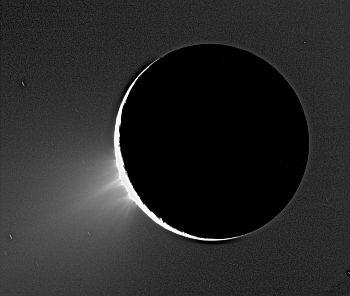 Scientists at the American space agency National Aeronautics and Space Administration have claimed that Saturn's moon Enceladus 'may contain life,' after they discovered new evidence suggesting presence of 'liquid water' beneath its surface.
Scientists at the American space agency National Aeronautics and Space Administration have claimed that Saturn's moon Enceladus 'may contain life,' after they discovered new evidence suggesting presence of 'liquid water' beneath its surface.
According to the scientists, the Cassini spacecraft flew through icy plumes created by ice volcanoes on Saturn's moon and detected negatively charged water molecules, in a clear sign that an underground sea exists.
On Earth, this short-lived type of ion is produced where water is moving, such as in waterfalls or ocean waves.
If there is liquid water on Enceladus, the scientists believe that the Saturn's sixth-largest moon could have the conditions necessary to sustain life, British newspaper 'The Daily Telegraph' reported.
In fact, high-resolution images already taken by the Cassini spacecraft -- a project of NASA, the European Space Agency and Italian Space Agency -- have shown the icy surface of Enceladus has a spreading Earth-like crust that has changed over time.
And, on Earth the spreading of the sea floor is driven by molten rock and the NASA scientists speculated the liquid beneath the south pole of Enceladus might be water.
Cassini scientist Andrew Coates said that the evidence gathered by the spacecraft pointed to other constituents for life, like carbon, plus a source of heat to keep water liquid.
"While it's no surprise that there is water there, the short-lived ions are extra evidence for subsurface water. And where there's water, carbon and energy, some of the major ingredients for life are present," said Dr Coates, from University College London's Mullard Space Science Laboratory.
"The surprise for us was to look at the mass of these ions. There were several peaks in the spectrum, and when we analysed them we saw the effect of water molecules clustering together one after the other," Dr Coates added.
The findings have been published in the latest edition of the 'Icarus' journal.
Text: PTI
Image: Enceladus, shown in this image captured by the Cassini spacecraft, is spraying icy particles into space from the area around its south pole.
Photograph: Reuters/ NASA/ JPL/ Space Science Institute





